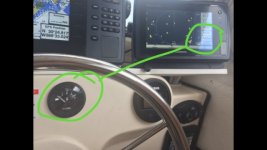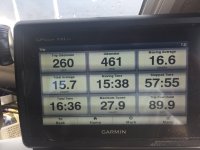I'm heading back from Pensacola Beach, FL to Blue Water Bay Marina about 50ish miles and I notice my fuel gauge showing empty. I added enough fuel to make it there and back, I thought. I'm still getting used to the boat.

Fuel gauge shows empty but computer shows 32.9 gallons. The computer has been dead on when filling up so I trusted the computer. I didn't have to call SeaTow so I made the right decision.

Fuel gauge shows empty but computer shows 32.9 gallons. The computer has been dead on when filling up so I trusted the computer. I didn't have to call SeaTow so I made the right decision.

